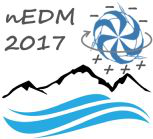Speaker
Mr
Jacob Thorne
(University of Sussex)
Description
We present details of the design, construction and initial tests of an apparatus for high voltage testing of a full-size cryogenic nEDM cell in liquid helium at 4.2K. The test cell is cylindrical and of 24 cm internal diameter with stainless steel electrodes and an insulating spacer. The cylinder axis of the cell is vertical and the insulator is located in grooves in the electrodes. The electrode separation can be varied from 0.2 cm to 2.6 cm and a voltage of up to 260 kV can be applied across the cell.
It has long been expected that a nEDM cell immersed in superfluid LHe at 0.5 K should permit E-fields much greater then room temperature experiments. Long et al [1] showed that over 400 kV/cm was obtainable in a large cell without an insulating spacer at 4.2 K, but that this was reduced dramatically as the temperature, and hence pressure, was reduced to below 2 K in a pumped LHe bath. Subsequent work by Davidson [2] in this laboratory on small spacerless cells showed the dielectric strength in the superfluid at 1.9 K could be restored to its 400 kV/cm value by pressurising the LHe to 1 bar.
Further work in this laboratory by Davidson [2] and Hill [3], and that presented here, shows that the introduction of a dielectric spacer reduces the value of the breakdown field, Ebd, for any given geometry.
Initial Ebd data as a function of separation with the full-size cell in LN2 show a clear reduction compared to data from smaller scale cells. We shall shortly begin measurements in LHe at 4.2 K with this apparatus.
The primary aim of our experiments is to determine whether an E-field of 100 kV/cm can be maintained in this 1.2 litre cell at 4.2 K. If this can be demonstrated, then such a result, together with Davidson's pressure dependence data, should inform the design of a future cryogenic nEDM experiment.
[1] Long et al, arXiv:physics/0603231, 2006 [2] A. J. Davidson, PhD Thesis, University of Sussex, 2011 [3] D. Hill, Master's Thesis, Unversity of Sussex, 2010.
Funding Agency
U.K. Science and Technology Facilities Council
| j.thorne@sussex.ac.uk | |
| Consider for Poster | Yes |
Primary author
Mr
Jacob Thorne
(University of Sussex)

